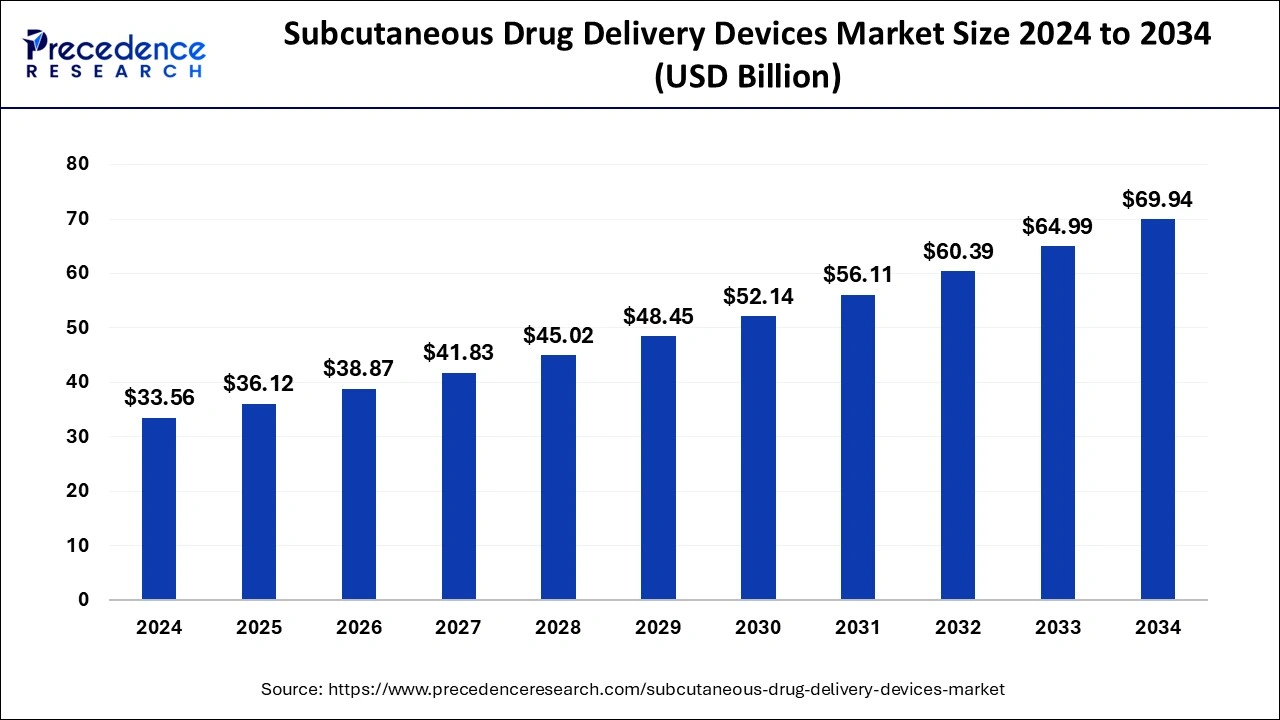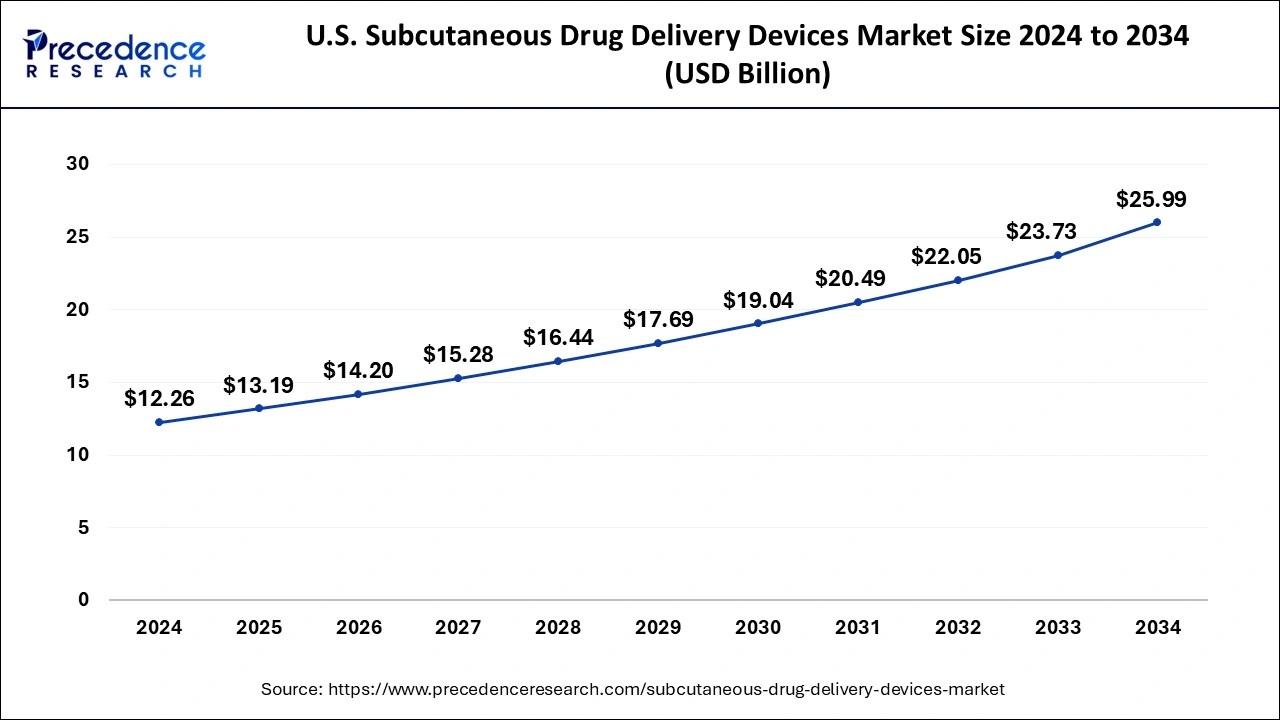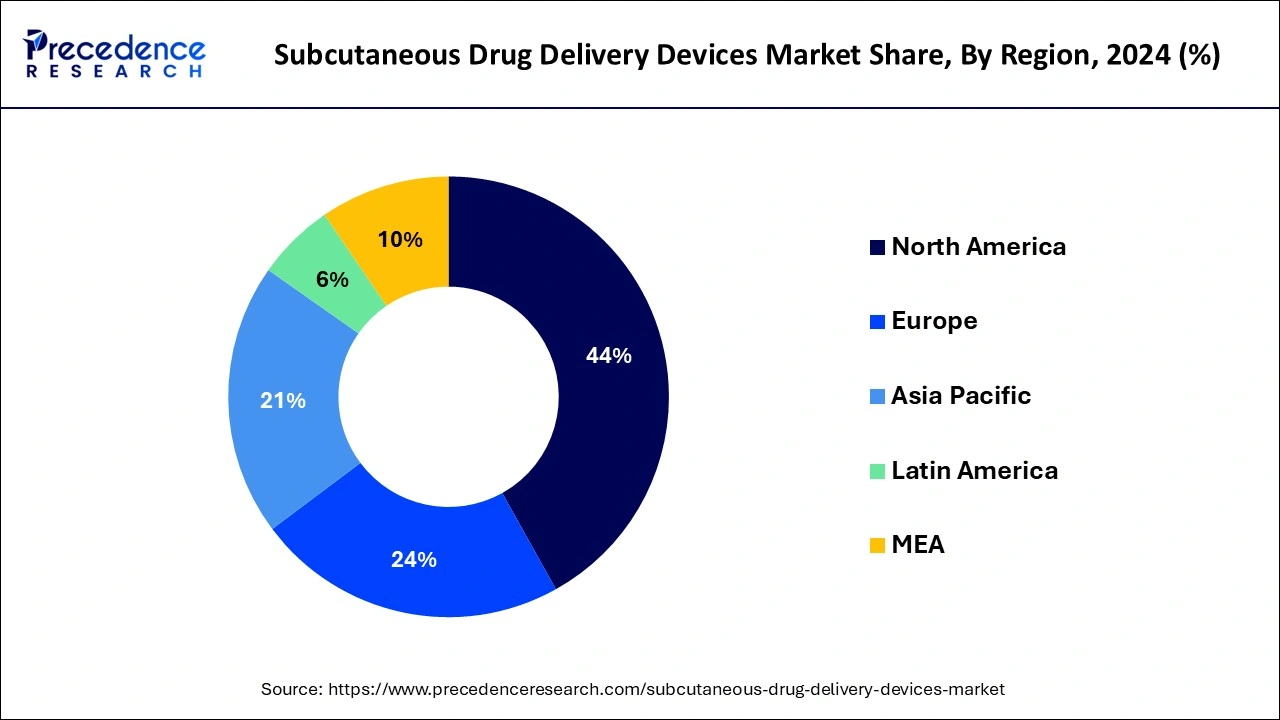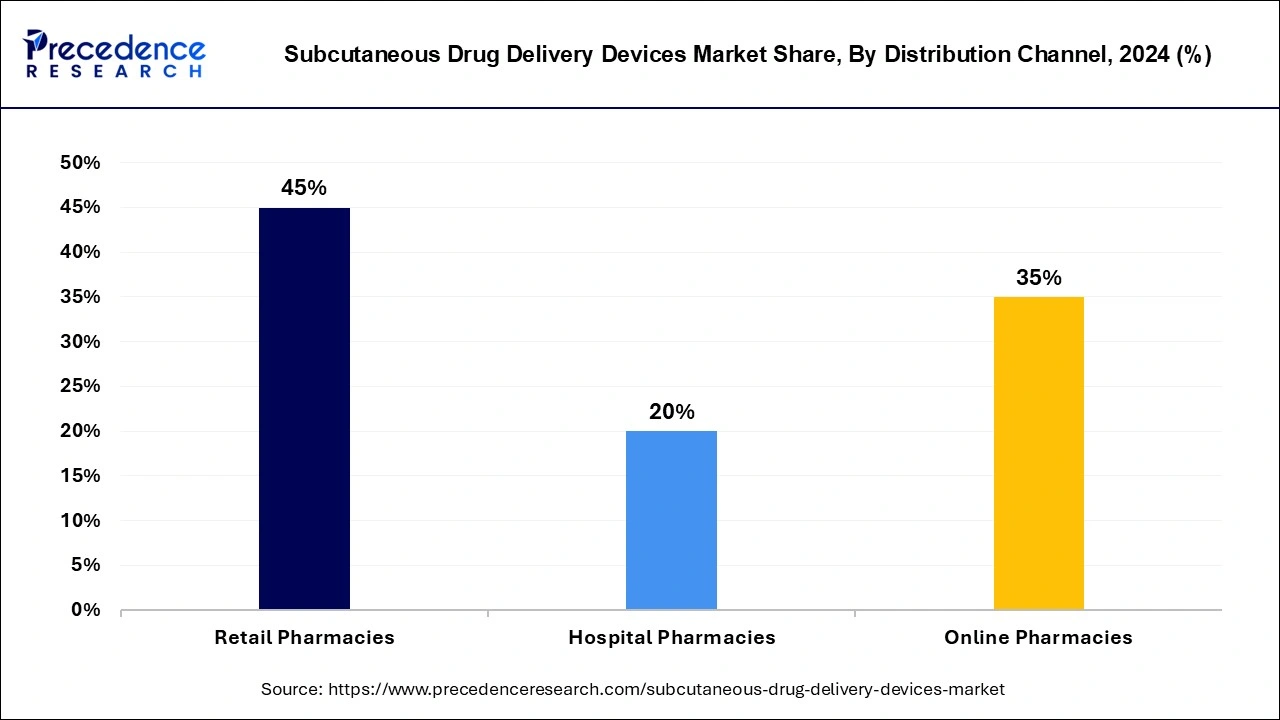Subcutaneous Drug Delivery Devices Market Size and Forecast 2025 to 2034
The global subcutaneous drug delivery devices market size was estimated at USD 33.56 billion in 2024 and is anticipated to reach around USD 69.94 billion by 2034, expanding at a CAGR of 7.62% from 2025 to 2034.

Subcutaneous Drug Delivery Devices Market Key Takeaways
- North America led the global subcutaneous drug delivery devices market with the highest market share of 44% in 2024.
- Asia Pacific is projected to grow at the fastest CAGR during the forecast period.
- By distribution channel, the retail pharmacies segment has held the major market share of 45% in 2024.
- By distribution channel, the online pharmacies segment is expanding at a notable CAGR during the forecast period.
- By product type, the pen injectors segment contributed the highest market share of 37% in 2024.
- By product type, the auto injectors segment is expected to grow at a solid CAGR over the forecast period.
U.S. Subcutaneous Drug Delivery Devices Market Size and Growth 2025 to 2034
The U.S. subcutaneous drug delivery devices market size was evaluated at USD 12.26 billion in 2024 and is predicted to be worth around USD 25.99 billion by 2034, rising at a CAGR of 7.80% from 2025 to 2034

North America led the global subcutaneous drug delivery devices market with the highest market share of 44% in 2024. The presence of developed healthcare infrastructure, presence of several top manufacturers in the region and the various developmental strategies adopted by them, and increased healthcare expenditure are several prominent factors that drives the growth of the North America subcutaneous drug delivery devices market. Moreover, the increased prevalence of various chronic diseases resulted in the huge demand for drugs and drug delivery devices amongst the population. Around 60% of the US population is suffering from one or more chronic illnesses.

Asia Pacific is projected to grow at the fastest CAGR during the forecast period. This is majorly attributed to the rapidly growing diabetic population in the region owing to the unhealthy food habits of the people. According to the International Diabetes Federation, around 60% of the global diabetic population lives in Asia. Therefore, the market players are expected to shift their focus in the Asia Pacific region. The rising disposable income, growing awareness regarding the diabetes management, and rising healthcare expenditure are the major factors that will drive the growth of the Asia Pacific subcutaneous drug delivery devices market in the forthcoming future.
Subcutaneous Drug Delivery Devices Market Growth Factors
The growing prevalence of chronic diseases and rising number of vaccinations that extensively utilizes the subcutaneous drug delivery devices like vial are the major factors that drives the growth of the global subcutaneous drug delivery devices market. The growing geriatric population across the globe is expected to foster the demand for the subcutaneous drug delivery devices. This because the geriatric people are more prone to various chronic diseases and frequently needs healthcare support. The healthcare expenditure associated with the old age people are more and hence, the rising number of geriatric people are anticipated to boost the consumption of the subcutaneous drug delivery devices. Moreover, the use of these drug delivery devices is growing because injecting drugs in the body is much more effectives than any other route of administration of drugs. Thus, the global subcutaneous drug delivery devices market is expected to grow at a significant rate during the forecast period.
The world is witnessing a significant rise in the number of patients suffering from numerous chronic diseases such as cancer, autoimmune diseases, respiratory disorders, cardiovascular diseases, diabetes, and various other type of diseases. According to the World Health Organization, the cardiovascular diseases accounts for around 18 million deaths and it is the leading cause of death across the globe. As per the International Agency for Research on Cancer, around 19.3 million new cancer cases were reported in 2020 and this number is expected to reach 28.4 million in 2040, globally. Apart from this, the rapid growth of the biopharmaceutical industry and development of various innovative drugs in the biologics and biosimilar have exponentially supported the growth of the subcutaneous drug delivery devices market. The government authorities like FDA and EMA have played a crucial role in granting approvals to the technologically advanced drug delivery devices that helped the manufacturers to gain consumers' confidence.
Market Scope
| Report Coverage | Details |
| Market Size in 2025 | USD 36.12 Billion |
| Market Size by 2034 | USD 69.94 Billion |
| Growth Rate from 2025 to 2034 | 7.62% |
| Largest Market | North America |
| Base Year | 2024 |
| Forecast Period | 2025 to 2034 |
| Segments Covered | Product,Distribution Channel,Region |
| Regions Covered | North America, Europe, Asia-Pacific, Latin America, and Middle East & Africa |
Product Type Insights
Based on the product type, the pen injectors segment dominated the market, accounting for over 37% of the subcutaneous drug delivery devices market share in 2024. This is attributed to the higher social acceptance, increased affordability of the consumers, easy-to-use feature, easy availability, and increased awareness regarding the pen injectors across the globe. The increased product approvals of the pen injectors played a crucial role in its growth. For instance, in April 2020, Sanofi acquired the US FDA approval for its new prefilled pen named Dupixent that serves the asthma, chronic rhinosinusitis, and atopic dermatitis patients at homecare. Moreover, in June 2019, Sanofi acquired the EMA approval for its ToujeoSoloStar Pens in Europe. Therefore, the new product developments and its approval by the government authorities greatly contributed towards the growth of the market.
On the other hand, the wearable injectors is estimated to be the most opportunistic segment during the forecast period. This is attributed to the rising number of needle stick injuries and the higher risks of getting blood-borne diseases associated with the use of injections. The wearable injectors are very efficient at administering the large volume and high-viscosity biologic drugs. Wearable injectors are digital drug delivery devices are offers convenience, and helps the patients to administer accurate doses at right time. These factors are expected to augment the demand for the wearable injectors in the forthcoming future.
Distribution Channel Insights
Based on the distribution channel, the retail pharmacies segment accounted for around 45% of the market share and dominated the global subcutaneous drug delivery devices market in 2024. The subcutaneous drug delivery devices allows the patients to self-administer the drugs as and when required by the patient. The easy availability, wide spread presence of retail pharmacies, increased awareness regarding the subcutaneous drug delivery devices, and increasing health consciousness among the population has augmented the growth of the retail pharmacies segment across the globe. Retail pharmacies are the traditional and the most popular channel for the distribution of medicines and drug delivery device all over the globe, which resulted in its dominance in the market.

On the other hand, the online pharmacies are gaining rapid traction among the consumers. The increased internet penetration and rapidly growing popularity of the online pharmacy platforms is boosting the market growth. The easy to use interface of the online pharmacy platforms, easy payment options, and quick home delivery are the major features provided by the online pharmacies that are expected to boost the growth of the subcutaneous drug delivery devices market.
The various developmental strategies like product launches, acquisitions, collaborations, and mergers fosters market growth and offers lucrative growth opportunities to the market players.
Subcutaneous Drug Delivery Devices Market Companies
- Insulet Corporation
- Enable Injections
- Amgen
- BD
- Consort Medical Plc
- Ypsomed AG
- Eli Lilly
- Novo Nordisk
- Sanofi
- Merck
- AstraZeneca
Key Market Developments
- In April 2021, Medtronic introduced a wearable injector that can be worn by the patients for 7 days for the treatment of diabetes.
- In April 2020, Sanofi acquired the US FDA approval for its new prefilled pen named Dupixent that serves the asthma, chronic rhinosinusitis, and atopic dermatitis patients at homecare.
- In June 2019, Sanofi acquired the EMA approval for its ToujeoSoloStar Pens in Europe.
- In December 2019, LEO Pharma and Portal Instruments collaborated to develop a needle-free subcutaneous drug delivery solution
- In June 2018, Insulet Corporation acquired approval from US FDA for its insulin management system called Omnipod DASH.
Segments Covered in the Report
By Product Type
- Auto-Injectors
- Pen Injectors
- Prefilled Syringes
- Wearable Injectors
- Needle-Free Injectors
By Distribution Channel
- Retail Pharmacies
- Hospital Pharmacies
- Online Pharmacies
By Geography
- North America
- U.S.
- Canada
- Europe
- U.K.
- Germany
- France
- Asia Pacific
- China
- India
- Japan
- South Korea
- Rest of the World
For inquiries regarding discounts, bulk purchases, or customization requests, please contact us at sales@precedenceresearch.com
Frequently Asked Questions
Ask For Sample
No cookie-cutter, only authentic analysis – take the 1st step to become a Precedence Research client
 sales@precedenceresearch.com
sales@precedenceresearch.com
 +1 804-441-9344
+1 804-441-9344